Listen to the article:
[acf field=”embed_code”]
In the minds of many fleets, drivers have become a commodity. The mindset becomes “What is the cheapest driver I can get in my fleet?”
And coupled with that mindset is the idea that turnover isn’t actually a bad thing. As long as you can keep a driver for X amount of time and hire them for X amount of dollars, turnover is just fine.
This “commodity” mindset will, of course, change the way you treat your drivers. And believe me, drivers know when you treat them like a commodity. Check out some of the quotes from a CCJ driver survey from 2018.
[box]
CCJ What Drivers Want Survey Quotes
[one_half] [/one_half][one_half_last]
[/one_half][one_half_last]
[testimonial author=”Experienced driver, dispatcher, terminal manager, and customer service manager – Phillip Keith”]“This is the way we do it. You take this load or I don’t need you no more.’ They didn’t really care about my son’s birthday or whatever.”[/testimonial]
[testimonial author=”Driver, 1 year experience – Nick Seevers”]“To them, we are nothing but scum.”[/testimonial][/one_half_last]
[/box]
The report found that only 1 in 10 drivers felt respected at their current company.
If you think turnover isn’t really a bad thing, then perhaps the sentiment of drivers isn’t important to you. But are you really taking into account the true cost of turnover?
Let’s take a look at the math.
[hr style=”3″ margin=”40px 0px 40px 0px”]
The Math of Hiring a New Driver
Advertising will cost you somewhere between $1,000 – $5,000 per driver depending on driver type, type of haul, driver population, etc.
Getting the driver to orientation will cost $150 for a bus ticket on the low-end or $750 for an airline ticket on the high-end. Then, you will need to pay for food and lodging. Food will cost you around $60 per driver and hotels will be about $100 for 3 nights.
Next, you have reports, background checks, and drug screening.
And finally, you have training, which includes truck prep, road tests, and paying a driver to administer the road test—unless you have a dedicated employee for that.
Add all that up and you’ll arrive somewhere between $2,000 – $10,000 to hire a driver. This, of course, depends on the type of driver you’re hiring, the route, the type of haul, the length of orientation, the distance drivers are traveling for orientation, and tons of little factors.
And maybe you’ve added all of those together and know exactly what it costs to bring on new drivers. But have you considered the currency of reputation?
[hr style=”3″ margin=”40px 0px 40px 0px”]
Does Fleet Reputation Equal Money?
The short answer is yes, but it’s more nuanced than a short answer. Let’s start with referrals. On average, 20% of your hires will come from referrals. Referrals are the cheapest hire you can get and a “commodity mindset” will drive the percentage down. Inversely, investing in driver wellness could increase the percentage of hires you get from referrals.
What would the effect of these percentages look like across the course of a year? Let’s look at a 500-truck fleet where 10% of your hires come from referrals and rehires vs. a fleet of the same size where 30% come from rehires and referrals. We will assume the same turnover rate for both fleets and the same number of empty trucks. The difference in how much each fleet would spend on recruiting drivers is about $400,000 over the course of the year! I’d say that’s pretty significant.
And honestly, it’s doubtful each fleet would have the same turnover rate, meaning the fleet who treats drivers like commodities would have an even bigger difference in their yearly budget.
For the sake of our example, we also assumed the same cost-per-hire. Here as well, and we see this with our clients, a bad reputation will increase your cost-per-hire. So, does reputation equal money?
[hr style=”3″ margin=”40px 0px 40px 0px”]
The Effect of Fleet Reputation on Your Driver Recruiting
If a bad reputation equals less referrals, an increased cost-per-hire, and an increased turnover rate, a fleet could be spending millions more than necessary recruiting drivers. And we haven’t talked about the efficiencies gained if you maintain a fleet of veteran drivers who have worked with you for a substantial period of time. At the end of the day, a fleet with constant churn would have less revenue coming in from drivers and more money going out for drivers.
So, I ask again. Have you really considered the cost of turnover? It is true that it costs money to invest in driver wellness and be more selective with your hiring. But I would wager that not nearly as much as a bad reputation. Do the math for your fleet, and tell us what you think.




